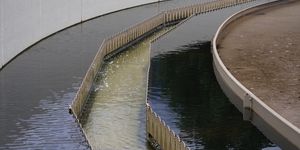Are Massive Seaweed Blooms Here to Stay?
The brown macroalgae Sargassum is not uncommon in the Atlantic Ocean. In fact, the Sargasso Sea on the western side of the central Atlantic Ocean is named for the presence of Sargassum seaweed. In regular amounts, Sargassum provides vital habitat for marine animals such as turtles and crabs and produces oxygen via photosynthesis.
However, since about 2011, massive mats of this seaweed have washed up on beaches in Florida, Gulf of Mexico, and the Caribbean. As it decomposes on the shore, Sargassum releases hydrogen sulfide gas, which smells like rotting eggs. In addition to creating smelly and unsightly problems for beachgoers, rampant amounts of the algae along coastal regions can entangle and drown animals such as sea bird, sea turtles, and dolphins. Sometimes, the seaweed will sink in water and smother corals and seagrasses. It’s also created issues for fisherman and those who depend on tourism income at the impacted beaches.
According to a team of scientists, this may be the “new normal” when it comes to Sargassum blooms. Using satellite imagery, the team tracked the increase in Sargassum blooms and have dubbed the recurrent influx since 2011 the Great Atlantic Sargassum Belt. Extending from West Africa to the Gulf of Mexico, the GASB reached record size in June 2018 extending 8,850 kilometers and containing 20 million metric tons of seaweed.
Lead author Dr. Chuanmin Hu from the USF College of Marine Science told USF reporters that "the ocean’s chemistry must have changed in order for the blooms to get out of hand.” The seaweed thrives when nutrient conditions are favorable and using environmental and field data the team pinpointed two suspect nutrient inputs. A natural nutrient input comes from the winter upwelling that occurs off the West African coast, delivering nutrients from deep ocean waters to surface waters. Another, which is a human-derived nutrient input, comes from Amazon River discharge in the spring and summer, which adds nutrients to the ocean, primarily nitrogen and phosphorus. Preliminary data suggest the seaweed upsurge correlates to increases in deforestation and fertilizer use.
In a news release from Florida Atlantic University regarding the study, research professor and co-author Brian Lapointe stated that “severe floods have recurred in the Amazon basin since 2009, which would result in extensive freshwater runoff and nutrient enrichment in the western Atlantic Ocean.” He continued that “It is reasonable to suggest that the 2011 massive bloom is therefore the result of nutrient accumulations since 2009.”
The team summarized the conditions associated with the massive blooms as large seed populations from previous year’s bloom, high nutrient supply from West Africa upwelling, and high nutrient supply from the Amazon River input. Water temperature is not yet identified as a factor. Lapointe concluded that recurrence of GASB “underscores the need for multidisciplinary research to better understand their ecological and biogeochemical impacts as well as their impacts on coastal environments, tourism, economies, and human health.”








